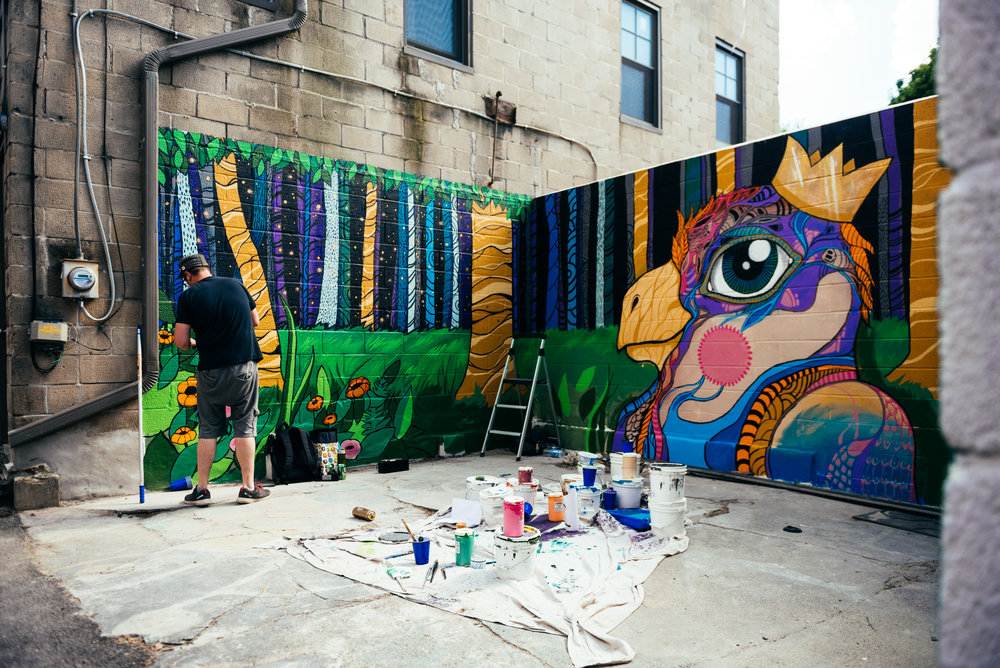In March 2022, the first episode of Prism was published. It told the story of rural and small-town artists, working hard to bring color and vibrancy to their communities. Since that first installment, this collaboration with the Pennsylvania Council on the Arts has shared the voices of workforce development advocates, small business owners, immigrants, local government officials, muralists, educators, hospitality workers, festival organizers, and more. The connecting thread between all of those guests, from every corner of the state, was their belief in the power of the creative community to improve and uplift Pennsylvania.
As we look back on ten episodes of Prism, we spoke with Karl Blischke, executive director of the Pennsylvania Council on the Arts. He shared his thoughts on this multi-year project, pulled out some of his favorite moments, and made an argument for the essential role of the creative economy.

Lee Stabert, host of Prism: Why did the Pennsylvania Council on the Arts decide to do a podcast? What were your goals with Prism?
Karl Blischke: The Council wanted to raise the visibility of creativity and creative-sector strategies related to community and economic development in Pennsylvania. So we thought, how can we do this in a way that’s engaging? And that’s when we started to think about a podcast. And then of course, the idea of partnering with Keystone Edge was that we could connect with a larger audience and a new audience. The goal is to spark interest, spark visibility, and spark connections.
One of the reasons that podcasts really excite me is that you’re actually hearing voices. You’re hearing people in their own words — and it’s something slightly different from just quoting someone in a story. You can hear the excitement in their voice. You can hear the passion in their voice. I think that really adds a layer.
Yeah, agree on all those things. And more.
So let’s talk about the creative sector, which is often talked about as having a coolness factor or being a bonus. But I think one goal of this podcast was to argue that, no, this is an essential part of economic development. This is one of the bricks that goes on the bottom. It’s important. Can you talk about sending that message via Prism?
A few years ago, we had the opportunity to visit with a lot of communities, large and small, across the state. This was part of our last strategic planning process. And we asked them, “What’s important for you and for your community?” We also asked, “How can we help support your goals?”

What we heard consistently, regardless of where we were having these meetings, is that the communities and their members thought it was very important that their place be a vibrant place. And in particular, they were concerned about being able to retain residents, and also to attract residents, visitors, talent, and ultimately investment. So it occurred to us, place is now a driver of decisions. And when it comes to quality of place, the creative sector is a differentiator for communities. The creative sector assets and the amenities and, of course, creators themselves are part of what makes a community attractive and competitive.
So looking back at these 10 episodes, are there any stories that really stuck out to you
There are compelling stories across all the episodes. That said, in season one, episode four, “Planting seeds so the arts can flourish,” we heard from two very different communities and two different leaders working in those communities: Silas Chamberlain in York and Charles “Chuck” Gray, who works in Corry. Now, they’re not the arts leaders. They’re the economic development leaders. It was helpful to hear from their perspective how they see their communities and how they see the creative sector working for their place. And it was very interesting to see where they agreed and, in some cases, deployed different strategies.

Another really compelling story was in season two, episode nine, “Pennsylvania’s festivals offer more than just fun,” where we heard from, again, two very different communities that are using a similar strategy around having a signature festival. And these festivals are really shaping the experience and perception of their communities. So we heard from the Chainsaw Carvers Rendezvous in Ridgway, and we heard from MusikFest in Bethlehem. And in both these cases, the festival was grounded in the history of the community — the lumber heritage region around Ridgway and the Moravian music history in Bethlehem. These events were created at a time when it was important for the residents to have something to do and to have something that they could be proud of. The festivals can ultimately be used to attract Pennsylvanians and people from all over the country, and in some cases the world, to their community.
Both of those episodes featured real dialogue between the two guests. And so I want to talk about the structure of this podcast. When we were conceiving Prism, we wanted to feature as many voices as possible, so doubling up the guests made sense. But, I think the result of that has been that each of these episodes is a conversation not just between host and guest, but between the guests themselves. That has been, to me, the most fun part of hosting.
That dialogue was a great idea. I wish I could have taken credit for it. I think what you see there is the opportunity to share those voices, but also to see the interviewees actually learning from each other in real time. There were several “aha” moments in exchanges where there was learning. I think that was great for listeners to hear because they were probably having a similar experience.
For instance, I think about the episode that featured gaming as an up-and-coming part of the creative sector (“It was going to be a viable career path — there are people who do this”). We had Professor Charles Palmer from Harrisburg University and Jessica Creane of iKantKoan. They both understood how the creative sector was propelling a moment. One was very much in the digital space, and one was a very different kind of experimental, immersive gaming experience from a small Pennsylvania-based business. In their dialogue, you heard a lot of similarities, but also real time “aha” and learning moments for both of them.

So looking forward, what does the PA Council on the Arts have on the docket in terms of trying to continue to spotlight these types of projects and keep the energy going?
So as we’re going into the next update of our strategic plan, this is very much on our mind. We’re interested in providing increased assistance, both from a technical and financial standpoint, to community-driven artspace development. We’d like to expand our ability to do that, to engage more communities, and to engage them over a longer period of time. I think that’s the kind of support that’s needed to make a stronger impact and a stronger ecosystem.
We’re also hoping that we’ll be able to strengthen and broaden partnerships. We are interested in those that want to co-invest in this creative ecosystem with us, whether they’re in the private or public sectors. We have really shifted our focus, expanding our investments in arts and cultural organizations, but also creative small businesses, creative entrepreneurs, and arts-based community and economic development. We’re looking to continue expanding those investments going forward.
Click here to listen to all 10 episodes of Prism.
LEE STABERT is editor in chief of Keystone Edge and host of Prism.



